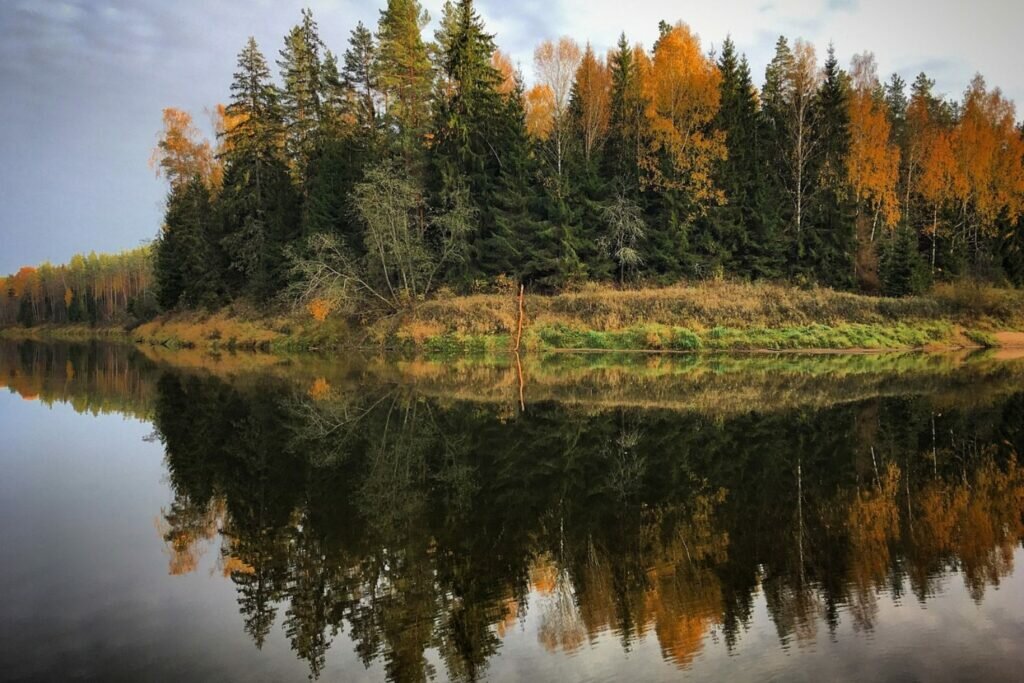by Laure Latham
Only an hour from Riga by car, Gauja National Park offers a glimpse into Latvia’s historical splendour, as well as a dramatic wooded valley winding along the River Gaujas. Though the national park would take days to explore on foot, my family and I visited the highlights in a day.
Depending on the season, I knew that we would enjoy a totally different nature experience in Gauja National Park, as the riverbed is lined with willow trees, and the valley’s slopes and terraces are covered in pine trees, spruces, birches and many hardwoods – oaks, ash trees and maples. October was a perfect time of the year, autumn painting the hills all shades of yellow, orange and red, and fallen leaves making all nature trails soft underfoot. Equally, the park would be glorious in winter snow, leafy spring or sunny summer.
This editorial reflects experiences you can enjoy on Sustainable Journeys 8-day Latvia by Rail trip. Find out more here.

To enjoy the best views over the Gauja valley, we parked at the foot of Turaida Museum Reserve (Turaidas muzejrezervāts) and climbed all 139 steps leading to the castle grounds. At the top, we followed signs to Turaida Castle, a rare (reconstructed) medieval red brick castle that towers above the valley, at the edge of a rocky promontory. Though I’m somewhat afraid of heights, I was able to walk up the main viewing tower to reach the top. What incredible sights! All around me, the view embraced 360 degrees of valleys and villages that had been virtually untouched by centuries, just as they were when viewed by the rulers of the castle back in the Middle Ages.
The viewing tower was not the only highlight of the Museum Reserve. Wandering through the vast grounds, I was thrilled to push open the door of the 18th-century baroque Turaida church and find a museum guide dressed in period costume. This painted wooden church was so tranquil that it felt as if we had stepped back in time. Further along, the rest of the estate provided an ethnological insight into peasant life in Latvia, with stables, a fishpond, a smithy and my absolute favourite, a bathhouse whose walls and ceiling were adorned with hanging bouquets of traditional fragrant dried herbs.
Following a steep downhill trail through the woods heading to Sigulda, we walked past Gūtman’s Cave (Gūtmana ala), the site of the famous Turaida Rose story, a 17th-century tale of thwarted true love, passion and tragic death. While the cave isn’t very big, its Latvian symbolism clearly captured the imagination of a nation, as evidenced by decades of love graffiti carved on the cave walls.
Keen to explore Gauja National Park for yourself? On this 8-day getaway, you’ll explore Riga, Gauja National Park, and Cēsis Hanseatic Town. You’ll stay in responsible accommodations and enjoy a cycling tour of Riga, enjoy beer tasting at Valmiermuiza craft brewery, and explore the coastal resort of Jūrmala.

Staying on the trail, we reached another significant manor of Gauja National Park, Krimulda Palace (Krimulda pils). Cream-coloured, with Doric neoclassical columns flanking a grandiose facade, Krimulda Palace was the seat of the German Lieven family in the 19th century. Closed to visitors, it has since been turned into a sanatorium for children and struck me as an eerie, abandoned place.
Under grey skies and with a chilly autumn breeze, it couldn’t have been less worthy of a Baltic Noir novel. The park and surrounding village feature a number of decrepit buildings that make for fantastic photogenic opportunities, albeit quite mysterious. They include a crescent of sunbathing cabins that the Latvian Red Cross built in the 1920s when the house was a hospital for tuberculosis sufferers.
Uphill through the park, I reached an observation tower, on a plateau where a cable car landed visitors coming from Sigulda across the river. Nearby stood the abandoned Krimulda Castle, reduced to only a few walls. Constructed with boulders, it was built in the 13th century but was burnt down by the Swedes in 1601.
Back in the car, we drove to the market town of Cēsis, where I fell in love with the atmospheric Cēsis Castle (Cēsu pils). Home to the Livonian Order, the castle is partially in ruin, so much so that we were given candle lanterns to explore two stone towers through unlit spiral staircases. It was pretty hairy and wild.


I finished the day with the Cēsis Museum of History and Art, an exquisite 19th-century stately home housing an amazing historical collection––and a viewing tower over the surrounding hills and the end of Gauja National Park.
Feeling inspired? Experience the magic for yourself by booking Sustainable Journeys 8 day Latvia by Rail trip.









